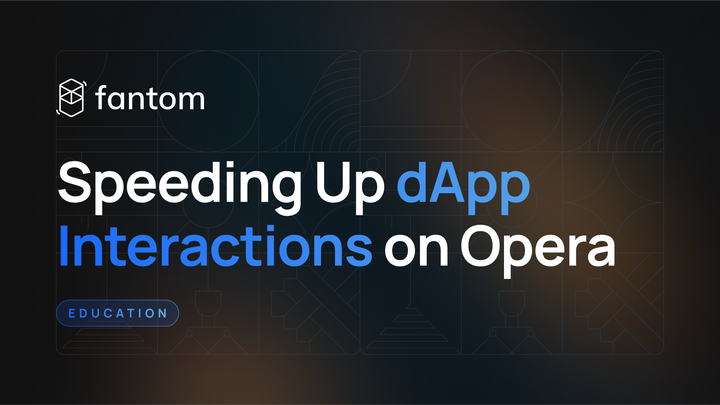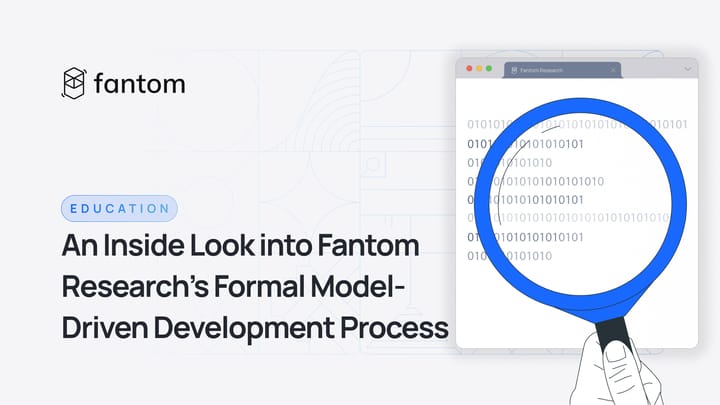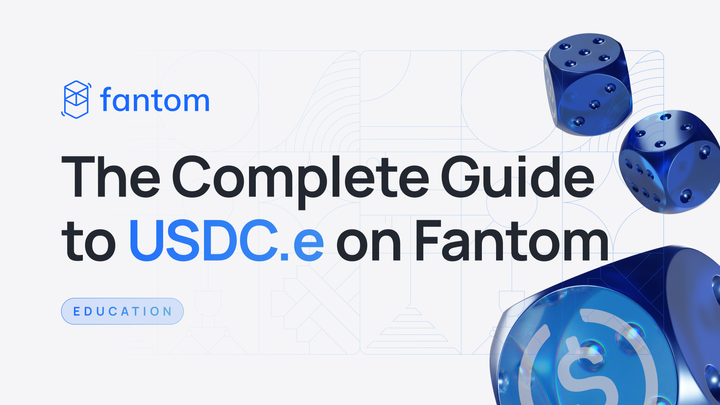Fantom at Consensus 2022

At a special session held June 11 at Consensus 2022, CEO Michael Kong took the stage with prominent Fantom community members and builders to discuss innovation across the Fantom network. Addressing what was a global in-person and virtual audience, the speakers offered important insights into Fantom technology, innovation in the ecosystem, and the growth of the community.
Here is a summary of what the speakers had to say.
Michael Kong, CEO Fantom
Fantom Key Features
- Subsecond, deterministic finality rather than probabilistic finality.
- EVM-compatibility simplifies deployment: if you can deploy on Ethereum, you already know how to deploy on Fantom.
- Proof-of-Stake ensures environmental efficiency.
- Fantom is entirely open-source and permissionless. Anyone can use the network or become a validator.
- Fantom is secure. The chain has been operational for over two-and-a-half years without any downtime. Fantom also offers true immutability and is considered unforkable.
- Fantom’s aBFT consensus model achieves high throughput via asynchronous transaction processing.
- All nodes are treated equally in consensus that is leaderless.
Fantom R&D
Fantom consensus is extremely fast and the team is working to capitalize on this efficiency. By addressing transaction performance limitations on the network, the team estimates that it can improve throughput four- or five-fold. Several significant upgrades have been planned for the short and medium-term.
Snapsync
This recently implemented solution allows nodes to synchronize with peers on the network in a fraction of the time that was previously required. On the Testnet for example, it normally takes one day to sync. Snapsync reduces this time to 15 minutes.
PebbleDB
When experimenting with this alternative to the more standard LevelDB, Fantom engineers discovered that they could reduce node memory usage by about 90%. An Alpha release is planned for API or read-only nodes within the next two weeks. The upgrade will subsequently be available for validator nodes.
Erigon
This hybrid flat storage model will increase block confirmation efficiency as the protocol transitions to a full implementation of flat storage.
Automatic node pruning
will allow nodes to prune on the fly without going offline.
StairDAG
Proof-of-Stake with StairDAGwill allow peer selection in constant time rather than logarithmic time.
Flat Storage
A flat storage system that will be superior to Erigon.
Fantom Virtual Machine
TheFantom Virtual Machine (FVM) will support efficient smart-contract execution and add simultaneous security checking.
Q&A with Sam Bond (Foundry)
Sam Bond: Does the Foundation plan to lower the 90% of staked tokens threshold currently required to reach quorum for passing governance proposals?
MK: Right now, for indicative votes, the threshold isn’t 90%; it can be as low as 55%. We are in the final stages of testing a solution that automates network parameter changes when a vote is passed ‒ for instance, staking requirements for nodes, how many FTM you can stake, and so forth. Once implemented, the minimum threshold for the passage of a proposal will be 66% of staked tokens. Automation of proposal implementations will make governance a truly public function.
Sam Bond: Are there plans to increase the incentives for validators to join the network as gas continues to drop?
MK: We do want to get more validators on the network. Right now, we have about 70 validator nodes, most of which aren’t run by the Foundation. On other networks, a higher proportion of nodes are run by Foundations. I’d like to see 200-300 validators on-chain.
Sam Bond: Can you say more about sharding?
MK: Ultimately, blockchain will be used as ubiquitously as the internet. Sharding will be one way of getting to infinite scalability where we can support a billion users.
Right now, a disadvantage of blockchain is that you have to confirm all transactions through all nodes in the network. The idea behind sharding is to have only parts of the network, or subsets of all nodes, confirm a transaction. With such a system, you can add more nodes and cater to more users.
Key for us is implementing a solution that allows for asynchronous transactions while maintaining efficiency, speed, and consistency. Sharding is a long-term goal.
Sam Bond: Has the Foundation been brainstorming any ideas to help mitigate gas spikes when massive liquidations happen?
MK: We've recently implemented a change that has optimized gas expenditure on the network. If you have used Fantom in the past month, you may have noticed that gas fees have dropped significantly.
The other way to reduce gas prices is by optimizing network performance and increasing throughput, as I mentioned in my presentation.
At the end of the day, we are building for users and a positive user experience.
Sam Bond: What is your opinion of Tomb? Is it adding liquidity to the ecosystem, or is it diluting Fantom?
MK: The problem with Tomb is the algorithmic model that they are using. They need to have a bigger discount on TBonds. Then I think they need to experiment with different algorithmic models that allow them to get closer to peg.
Owen P, Business Developer, SpookySwap
In just over one year, since its launch in April 2021, SpookySwap has grown into a top 5 DEX by volume across the crypto industry. In many ways, it is emblematic of how projects in the Fantom ecosystem have succeeded in innovating and building loyal communities of users.
Spooky’s early core values
- To offer the best user experience in crypto.
- To focus on volume rather than TVL.
- To provide a truly decentralized platform.
Spooky today
Spooky has built a fast front-end, a DEX with the polish of a centralized exchange, and an easy-to-use bridge built on Multichain technology. Low trading fees of 0.2% versus the more standard 0.3% helped draw significant volume.
Key Statistics
- 122,000 users and 19,000 trading pairs (Q1 2022)
- 75 submitted governance proposals gauge successful decentralization
- 5000 MagiCat NFTs sold out in 5 minutes in October 2021, indicating an active and loyal community. These NFTs will soon be stakable.
Spooky continues to grow and the team continues to hire even in the current bear market.
Michael “Cass” Kennedy, Security Engineer, Byte Masons
As an open-source, permissionless, and performant network, Fantom is frequently called the “people’s chain.” If this is the case, then Byte Masons are what is arguably the “people’s team” on Fantom. From the popular Reaper Farm aggregator to the forthcoming Reliquary DeFi platform, Byte Masons builds DeFi tools that are easy to use and accessible.
Building a successful technology platform
Innovation must be paired with efforts to make technology usable and comprehensible to the average user.
The Byte Masons’ approach is to focus on abstraction that makes complex actions easy to execute and reduces the cognitive load on users.
Reaper Farm is an example of abstraction in practice: the dApp is a layer built on DeFi protocols that opens access to complex investment strategies via simple and easy-to-use products.
Abstraction on Reliquary
Byte Masons’ forthcoming dApp Reliquary abstracts complex operations through composable NFT receipts that represent positions in a liquidity pool. These NFTs can be redeemed for underlying assets or traded on the market at a premium.
Responsible Abstraction
Abstraction also entails taking responsibility for asking questions about how UI might shape user decisions.
Byte Masons approaches this question by developing a programmatic framework to assess asset risk across protocols. Object data-driven risk analysis is the cornerstone of effective application design. By being aware of risks, users can begin to guide themselves and make intelligent decisions.
Pete, Founder, Tank Wars
As one of the first games on Fantom, Tank Wars is both an innovative, NFT-based game and a component of a rich, evolving Metaverse.
Team Background
The core members are affiliated with FiberBlock. They began investing in cryptocurrencies in 2013 and started a mining farm in Vietnam. They learned about Fantom in 2018.
The team started developing Tank Wars in November 2021. V1 of the game launched earlier this year.
Key Statistics
- 3000 Tank NFTs are listed in the marketplace.
- Users from 95 countries play the game. 5400 players are located in the Philippines, and 2,700 players are in the USA.
- Total user spend-time on the game is greater than 39,000 hours, which is more than 4.5 years.
- Over the last two weeks, more than 1 million battles have been played without any issues whatsoever.
V2 of Tank Wars, including a mobile version, will be out soon, and plans are underway to expand the game platform into a metaverse.
Doublesharp/Justin Silver, Fantom Community Developer
Justin Silver, aka Doublesharp, is an experienced developer who has supported numerous projects in the Fantom ecosystem with innovative solutions. In addition to being an invaluable member of the community, he is a regular on FTM Alerts.
Counterfactual NFT smart contracts open a number of use cases that extend the utility of NFTs. Counterfactual refers to something that does not exist yet, but will in the future.
Two EIPs in particular support counterfactual smart contract design:
- The Create2 EIP enables smart contract deployment to a precomputed address.
- The Minimal Proxy Contract (EIP1167) to cheaply clone contract functionality in an immutable way. This standard specifies a minimal bytecode implementation that delegates all calls to a known, fixed address.
In addition to being counterfactual, the NFT smart contracts that Doublesharp has deployed are ephemeral: when called, they complete required functionality and then self-destruct. This ephemerality enhances security and saves gas by reducing the storage needed on the blockchain.
Use Cases
- MowsePack: The use of counterfactual contracts supports composable Mowse PFP NFTs.
- Portalheads: Using Minimal Proxy Contracts enabled the Portalheads team to mint each NFT from a unique address associated with a specific royalty, thereby simplifying the royalty distribution.
- Revest Finance: Revest locks up assets behind NFTs that have vesting and unlock schedules. Using minimal proxy deployments allows the assets behind the NFTs to be stored in separate addresses, making it impossible for users to withdraw more than they own.
- PaintSwap: PaintSwap is introducing non-custodial sales in their V3. The design pattern here enables separate vaults to be created for each NFT, which supports accurate holder counts and increases security.
- Liquid staking: Staked tokens must be unstaked and sold to be transferred. By abstracting the staking process behind a minimal proxy using an NFT as a key, you can create a stake using a proxy address. That NFT becomes transferable in a process that unlocks liquidity.
Austin Rampt and Clay Kilgo from FTM Alerts
Much of what is so valuable in Fantom’s community today derives from the tireless work of the FTM Alerts team to stimulate dialogue and educate the Fantom user base.
Clay Kilgo/”Crypto Clay”
Innovation and partnerships across the Fantom ecosystem support “power user” dApps and sustain a vibrant community.
Innovation
Beethoven X offers weighted pools to allow investors to diversify holdings within one liquidity pool reminiscent of an index fund.
Beethoven X has also released boosted pools whereby liquidity in Beethoven X pools is put into Yearn vaults where it earns compounded interest in a highly capital efficient process.
Partnerships
Equally important in the Fantom ecosystem is the symbiotic relationship that protocols have formed. The ability to stake xBOO tokens on Beethoven X is an example of a productive partnership.
Another example is Liquid Driver, which provides liquidity on-demand to exchanges, offering users both Liquid Driver tokens and liquidity pool rewards as incentives.
Liquid Driver’s products rely on partnerships and highly collaborative relationships with projects in the Fantom ecosystem.
These relationships and innovations are based on disruption and creation, which brings us to Fantom technology, which offers the required speed, security, and cost-efficiency that enables builders on the network.
Austin Rampt
FTM Alerts began as a show to support the Fantom blockchain but has grown into a large-scale case study on what it takes to build an enduring and committed community.
Defining Community
Community represents a feeling of fellowship with others as a result of having common attitudes, interests, or goals. The operative word is feeling. This sense of belonging is not only a desire but a need. Fostering this feeling becomes more difficult in the pseudonymous world of crypto.
Community Building Strategies
- Consistency is one way that FTM Alerts has fostered a feeling of community. FTM Alerts airs a show every Thursday, focusing on news from the Fantom ecosystem.
- Transparency accompanied by trust is important. FTM Alerts consistently rises above factions to underscore that they are being truthful and reflective.
- Access gives the audience a sense of participation. FTM Alerts allows live comments that they address on air.
Collectively, the presentations affirmed that the community remains incredibly energized, and there is extensive building on the protocol. Will 2022 be remembered as the year of the bear market? At Fantom, we’re committed to making it a year of growing synergies across the ecosystem.



